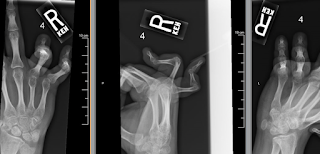Severe camptodactyly can be a challenge as it will limit function and may cause pain. This is less common in childhood and more common for the adult with untreated camptodactyly. I have previously shared thoughts on camptodactyly HERE.
Treatment of camptodactyly in the child begins with therapy. Depending on the nature of the camptodactyly, this may be curative or may provide sufficient improvement to avoid the need for surgery. Rhee, et al (including senior author Baek) showed how effective therapy can be, especially in the younger population MORE INFO HERE. In those patients that remain with functional challenges after failing 3-6 months of therapy, surgery for camptodactyly can be helpful. We have shared our approach in the Journal of Hand Surgery HERE.. We do not regularly perform a tendon transfer to power extension (straightening) as we fear the finger may be stiff and straight which is a bigger functional challenge than the finger that will not completely straighten.
The concern with untreated, severe camptodactyly is the development of arthritis at the PIP with permanent stiffness and pain, That, indeed, is how our patient presented. He had isolated camptodactyly of the ring and small finger. The fingers interfered with function given their severe flexion posture. He did not have other medical conditions and requested surgical intervention. Unfortunately, as might seem obvious, if there is arthritis, the option of providing additional motion through releases does not make sense. Therefore we elected to proceed with fusion of the PIP joints in a better functional position with the idea that this would address the pain as well as improve function.
 |
| Xrays in severe camptodactyly |
| Severe camptodactyly of the ring and little fingers |
| Severe camptodactyly but with maintained flexion of the fingers. |
This patient underwent succesful fusion surgery.
 |
| PIP joint fusion for severe camptodactyly |
I do not routinely push for surgery in camptodactyly. I give families that option if therapy fails. I explain why I think it will be helpful for function (and appearance). But I never consider it mandatory. This patient, and patients like him, illustrate the danger of untreated camptodactyly– that is- worsening posture which interferes with function and potentially arthritis at an early age which causes pain. These risks should be made clear to those families hesitant to consider surgery for camptodactyly (when the patient has failed therapy).
My Bio at Washington University
email: congenitalhand@wudosis.wustl.edu
Please CLICK HERE to support our research.
Designate my name. Thank you!
This is very helpful. I’m 21 and have camptodactyly in my right pinky finger. I’d say about 70 degrees in stiffness and a curvature towards the ring finger. I went to a hand doctor when I was 17 and he confirmed that it was indeed camptodactyly. I feel moderate to slight constant pain in the finger and have never been able to rest it flat on a table. My situation is far less severe than the man in this article so I have hope that therapy will help. I’ll consistently stretch and look up therapy tips.
Good luck with therapy. I am not certain that therapy will help dramatically at this point but always worth finding out. Other options (like surgery) really depend on how much this bothers you.